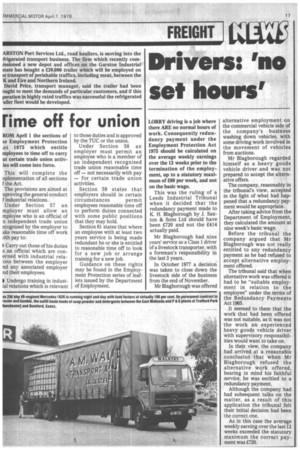Drivers: 'no set hours'
Page 19

If you've noticed an error in this article please click here to report it so we can fix it.
LORRY driving is a job where there ARE no normal hours of work. Consequently redundancy payment under the Employment Protection Act 1975 should be calculated on the average weekly earnings over the 12 weeks prior to the termination of the employment, up to a statutory maximum of EN per week, and not on the basic wage.
This was the ruling of a Leeds Industrial Tribunal when it decided that the redundancy payment made to K. H. Blagborough by J. Saxton & Sons Ltd should have been £720 and not the £414 actually paid.
Mr Blagborough had nine ;ears' service as a Class I driver of a livestock transporter, with a foreman's responsibility in the last 3 years.
In October 1977 a decision was taken to close down the livestock side of the business from the end of November.
Mr Blagborough was offered alternative employment on the commercial vehicle side of the company's business washing down vehicles, with some driving work involved in the movement of vehicles from auctions.
Mr Blagborough regarded himself as a heavy goods vehicle driver and was not prepared to accept the alternative offers.
The company, reasonably in the tribunal's view, accepted in the light of what had happened that a redundancy payment would be appropriate.
After taking advice from the Department of Employment, they calculated the amount at nine week's basic wage.
Before the tribunal the company argued that Mr Blagborough was not really entitled to any redundancy payment as he had refused to accept alternative employment offered.
The tribunal said that when alternative work was offered it had to be "suitable employment in relation to the employee" under the terms of the Redundancy Payments Act 1965.
It seemed to them that the work that had been offered was not suitable, as it was not the work an experienced heavy goods vehicle driver with supervisory responsibilities would want to take on.
In their view, the company had arrived at a reasonable conclusion that when Mr Blagborough refused the alternative work offered, bearing in mind his faithful service, he was entitled to a redundancy payment.
Although the company had had subsequent talks on the matter, as a result of this application the tribunal felt their initial decision had been the correct one.
As in this case the average weekly earning over the last 12 weeks exceeded the statutory maximum the correct payment was 020.








































































































































